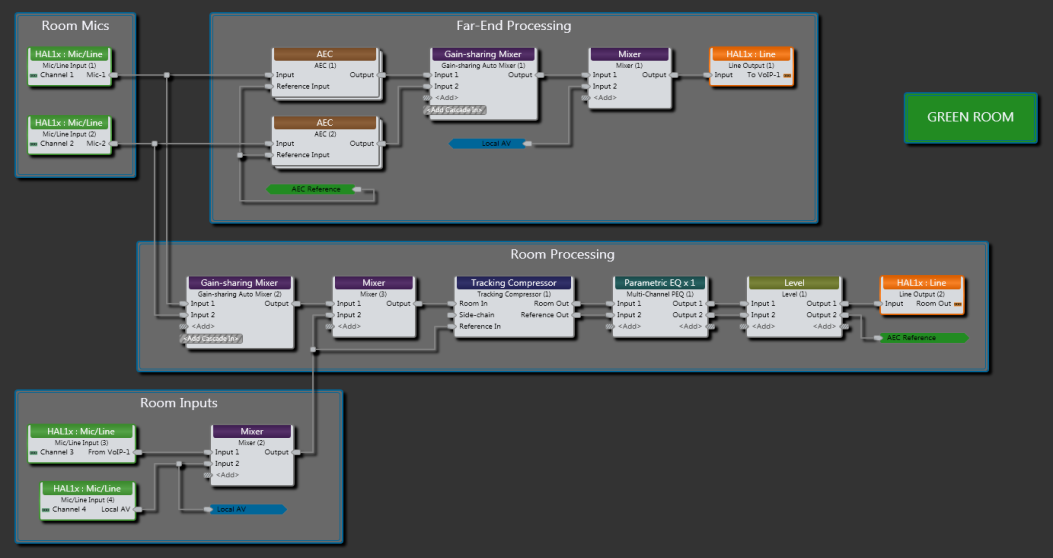Basic Halogen Conferencing with Voice Lift
Now that we’re more comfortable with the basic principles of conferencing, let’s add Voice Lift to a configuration. Voice Lift provides near-end microphone sound reinforcement for audio within a room so that everyone in the near-end room can hear clearly those who are speaking. The configuration shown below supports local speech reinforcement. What is sent to the far-end is unchanged from our previous example. The difference is in the Room Processing portion, which now supports local speech reinforcement. While this adds a bit of complexity, Halogen provides the blocks required to keep it relatively simple.

Microphone inputs for the room are taken before the AEC blocks and mixed with a Gain-sharing Mixer as shown. This signal is then mixed with the signal from the far-end and local AV sources. At the Tracking Compressor input, we now have two available mixes for the room and reference: one with from-far-end, local AV and local microphones and one with just from-far-end and local AV. There are a couple of different ways to use these two mixes.
First, let’s consider an example with a head table where the microphones are located and a larger audience area that requires Voice Lift. Voice Lift is not required at the head table so loudspeakers in this zone use the mix without Voice Lift. And because the mix without Voice Lift is most closely coupled with the microphones, it is also used for the AEC reference. The mix with the microphone signal serves the audience area. This is a very basic mix-minus application. More complex mix-minus applications are outside the scope of this document, but the principles are the same.
Second, let’s consider an example where microphones are less segregated and more tightly coupled with local sound reinforcement. This application is a bit less straightforward. Which signal should be used for the reference? Well, it depends. If ERL is poor, a better choice is to use the mix without near-end microphones for the AEC reference as doing so avoids adding AEC artifacts to speech sent to the far-end. If ERL is very good, using the mix with near-end microphones may improve performance. It is a misconception that including the local microphone mix in the reference subtracts all speech in the AEC block. AEC only subtracts the portion of speech it estimates will arrive from the local loudspeaker and in some cases, this can be a good thing. When in doubt, the reference should use the mix without the microphone signal.
In both scenarios, we need to ensure that both mixes receive identical signal processing as shown above. Halogen provides multichannel and tracking DSP blocks that help satisfy this requirement. In this example, a Tracking Compressor applies compression based exclusively on the Room signal and applies the required gain adjustment to both Room Out and Reference Out signals. The compressor is followed by a Multichannel PEQ and a multichannel Level control that apply identical equalization and level adjustment to both signals. It is important to Link to a level control that affects both signal paths and is located before the Reference output. Without these special blocks, a system designer would need to set up independent processing blocks for each signal path and somehow ensure that they stay in sync.
Halogen also offers Multichannel Shelf Filter and Tracking ANC (Ambient Noise Compensation).
A few things worth noting:
- It is important to place all dynamics processing and any other blocks that a user may adjust during operation before the reference location. Failing to do so will adversely affect AEC operation.
- It is equally important to not locate dynamics processing or any other blocks that a user may adjust during operation between a microphone and an AEC block as this adversely affects AEC operation.
- It does not adversely affect AEC performance to place fixed equalization on a microphone input before it is split between the AEC and local Voice Lift mixes. This is often highly desired as low-cut and PEQ requirements are more dependent on the microphone and you avoid duplicating processing for AEC and the local mix.